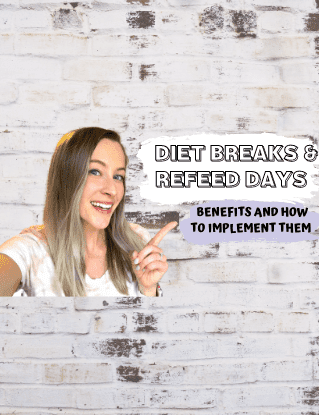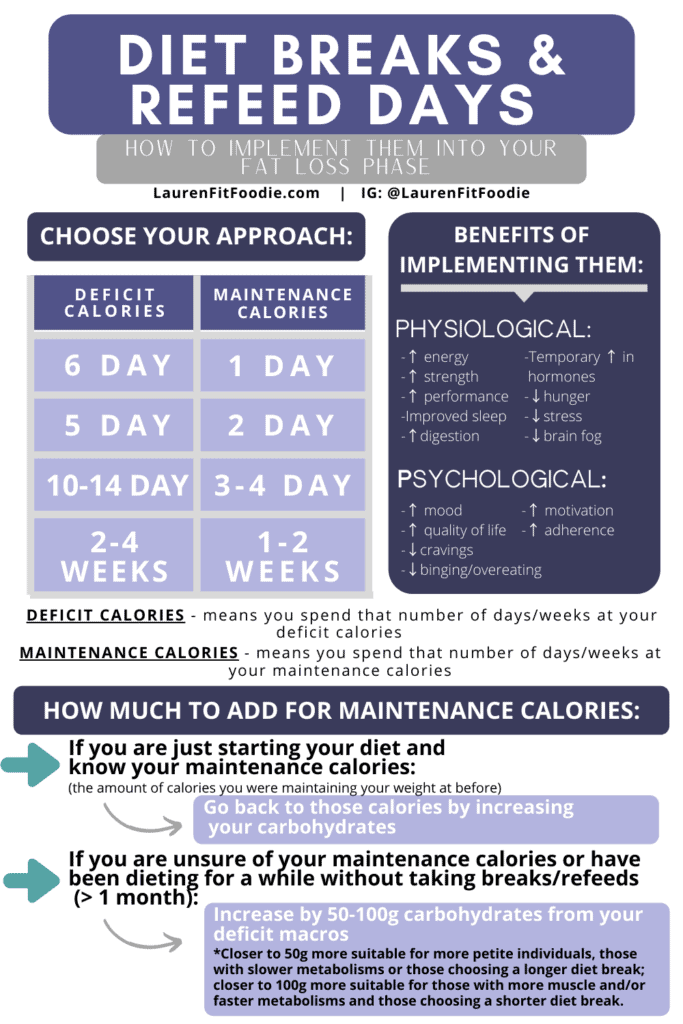This post may contain affiliate links. Please read my disclosure policy.

Diet breaks and refeed days are a helpful strategy to implement during your diet or fat loss phase. They provide a multitude of physiological and psychological benefits and have been found by many researchers and coaches like myself to help clients extend their diet longer, and ultimately see more results.
If you haven’t already, check out my YouTube where I explain diet breaks and refeed days more in depth!
In this video I cover:
- What are diet breaks and refeed days?
- What are the benefits?
- Who should utilize them?
- How to implement them?
It’s important to note that a “diet break” or “refeed days” are not a free for all. When we implement them, we are not saying “the heck with tracking” and eating everything in sight – but instead, they are structured days added into plan during your fat loss phase that again, provide a great number of benefits without reversing any progress that has already been made.
There are many different ways you can approach adding diet breaks and/or refeed days into your fat loss phase and just like many things, it is not a “one size fit all.” Truly, it is best to pick an approach that you can sustain long term and one that fits well with your life.
Choose your approach:
- 6 day deficit – 1 day refeed
- 5 day deficit – 2 day refeed
- 10-14 day deficit – 3-4 day refeed
- 2-4 week deficit – 1-2 week diet break
Which approach is the best?
Again, there is no right answer here. More than anything, it is important you choose one you can stick to for a long period of time. Because if you can’t, then you simply aren’t going to reap as many benefits. You are going to have to dive deep and ask yourself some questions to really determine which one is best for you.
6 day deficit – 1 day refeed:
This is probably the least common approach, simply because not as many psychological or physiological benefits are seen. You still can increase muscle glycogen stores which is helpful in maintaining strength and keeping performance high in the gym. With this one there isn’t as many improvements in sleep, stress, brain fog, and many other biofeedback markers – but this is the case for the general population. For some people this approach does work very well and they feel better and mentally and physically from it. It also provides an extra day in a deficit from the 5 day deficit – 2 day refeed approach, which may help you see results slightly quicker since you are in a deficit for a greater number of days.
5 day deficit – 2 day refeed:
This is probably the most common approach just because it is easy to stick to and does reap more benefits than the 6 day deficit. With this approach, you see greater improvements in your performance in the gym, improvements in energy levels, mood, and more. Having two back to back days as opposed to just one allows the body time to improve on biofeedback markers to a greater extent. Again, this varies from person to person, and you’re going to need to assess which you respond to best, but this holds true in most cases. Many people also like this one simply because it is so easy to fit into their life! They can hold steady to the deficit all week and have their refeed days on the weekend to allow for more wiggle room in food choices with family or social outings.
10-14 day deficit – 3-4 day refeed:
This one is my personal favorite. Mainly because it is the one I have seen the most results with. There is a range of days, because again, its up to you how you want to implement them. Personally, I like having 11 days in a deficit with a 3 day refeed because that equates to an even 2 weeks. For some people, there metabolism can be more resistant and they really need more time in a deficit to start seeing progress. 10-14 days is perfect for this, and also not long enough in a deficit where you feel like you’re going crazy. Having 3-4 refeed days provides even greater improvements in biofeedfack, both psychological and physiological, than the later two and also to a greater extent. I find that you are even more ready to continue pushing with your fat loss phase after having those 3-4 days to recharge. And you feel amazing!
2-4 week deficit – 1-2 week diet break:
Just like I mentioned in the 10-14 deficit approach, there are some people who just need more consistent time in a deficit to start seeing results. This approach is beneficial in those cases. More time is spent in a deficit and then more time is spent is spent in a period of higher maintenance calories – which provides the greatest improvements in biofeedback than all other approaches. There are pros and cons to this one (just like all of them), like having to stick to the deficit longer, and the diet taking longer – but for those who are not in a rush and really want some flexibility in their dieting phase – this approach is a great choice.

How much do I increase by during my diet break or refeed days?
When we have our diet break or refeed days, the goal is to increase calories (in the form of carbs) to your current maintenance calories. It is important to note that our maintenance calories are not always going to be the same and they do adapt to the amount of calories we are consuming. This is true when we are adding calories back in (through a reverse diet) and when we are in a deficit (fat loss phase). For that reason, the amount of time you have been in a deficit will dictate your maintenance calorie target.
If you have already been tracking macros and/or calories (while not already in a fat loss phase!) and you know what your maintenance calories are – you simply take your deficit macros and raise then by however many carbs in takes to reach your maintenance calories.
For example: if you have just finished up a period at maintenance phase (within the past month) and were maintaining your weight on 2000 calories, those are your current maintenance calories because your metabolism hasn’t been in a deficit long enough for metabolic adaption to occur. Say you determine your deficit macros to be:
130g protein, 50g fat, 170g carbs
In this case, you would need to add 350 calories to hit your maintenance calories. (350 calories divided by 4 calories/g of carbs = 87.5g carbs) – so you would add 88g of carbs to your deficit macros. Making your maintenance (diet break/refeed day) macros:
130g protein, 50g fat, 258g carbs
If you have not already been tracking your macros/calories OR you have been dieting for longer than a month – simply take your deficit macros and raise then by 50-100g of carbs. 50g of carbs is the minimum we need to really reap the benefits. There is no sure fire way to know exactly what our maintenance calories are after dieting for a while once metabolic adaption does occur (we can make guesstimates based on weight trends, but still not always accurate and easier to just to take deficit calories and add in 50-100g carbs).
50g may be more suitable if you are a petite individual, someone who has been in a deficit for a long period of time (talking 3 months or more), or someone choosing a longer refeed/diet break.
100g may be more suitable if you are taking doing a 1-2 day refeed, have a faster metabolism, or have a greater amount of muscle mass.
If you feel like you are somewhere in the middle, 70-75g of carbs may be a good place to start.
For example: you have been at deficit macros for 2 months and haven’t implemented any diet breaks or refeed days but you want to now. Say your deficit macros are at:
130g protein, 50g fat, 170g carbs
You decide you want to do a 3 day diet break, have a moderate metabolism (not slow or fast) so you decide adding 75g of carbs would be a good place to start to test out and see. You would just add 75g of carbs to your deficit macros, making your maintenance (diet break/refeed day) macros:
130g protein, 50g fat, 145g carbs
Like I mentioned before, there is no surefire way to know exactly how much to add, but you can make a good guesstimate and assess your weight trends to determine if the amount you added was appropriate. For a real life example of this regarding my weight trends, watch my video above. When you have these refeed days your weight IS expected to go up. That is totally normal because you are eating more calories, particularly carbs, which hold onto more water – therefore increasing scale weight. But what you should be looking for when you are analyzing your weight trends is that your weight should go back to what it was before you had the diet break or refeed day 3-4 after your last day of refeed.
If it lingers, you may have overshot your maintenance calories. If that is the case, don’t change your deficit calories, but just decrease your refeed macros by 10-20g next time. It is also important to note that other factors could be causing the scale weight to be elevated as well – being on period, having higher sodium than usual, decreased quality of sleep, digestion, etc. You may not have overshot – weight may still be elevated because one of those reasons, so we have to consider that as well.
